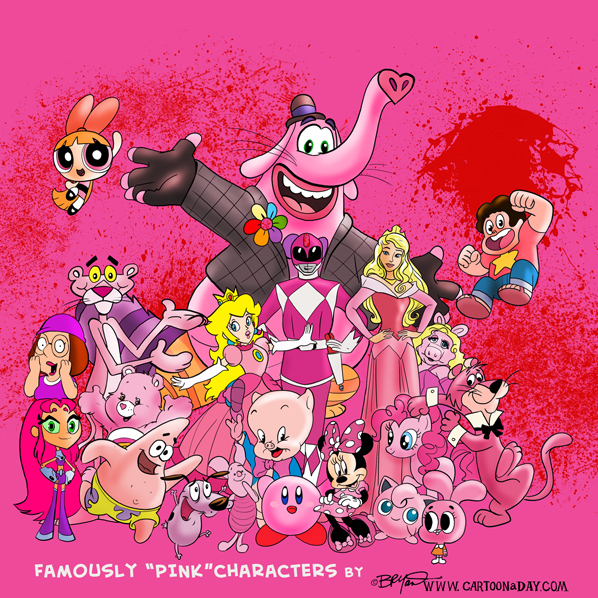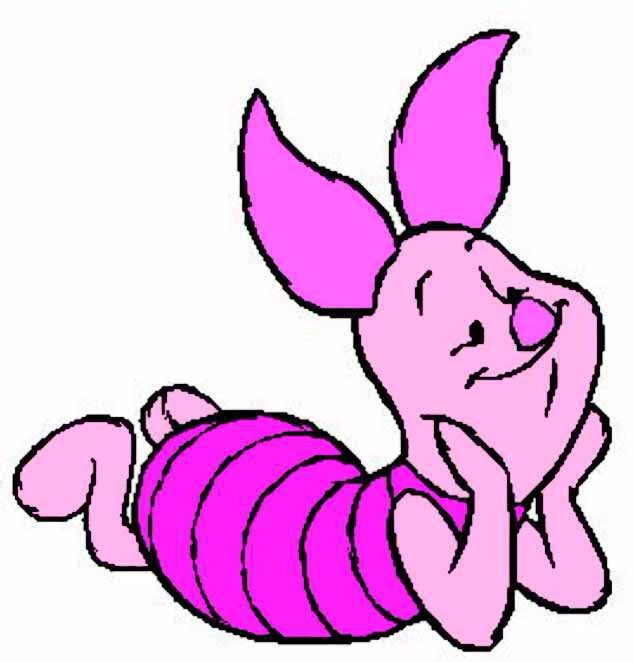When you think about cartoon characters pink, your mind probably jumps straight to the iconic ones that have been around for decades. But there's so much more to this vibrant color in the world of animation than meets the eye. From lovable mascots to fierce warriors, pink cartoon characters are everywhere, and they bring a sense of fun and whimsy that’s hard to resist. If you’re here, chances are you’re curious about these delightful creations and how they’ve shaped our childhood memories and pop culture. So let’s dive in!
It’s not just about the color, though. Pink cartoon characters often symbolize certain traits—like kindness, playfulness, or even rebellion. Think about it: characters like Pink Panther, Hello Kitty, and even the iconic Bubblegum from Adventure Time all carry unique personalities that go beyond their appearance. And hey, who wouldn’t want to learn more about the magic behind these beloved figures?
Whether you’re a fan of classic cartoons or modern animated shows, pink cartoon characters have something for everyone. In this article, we’ll explore the history, significance, and evolution of these characters. We’ll also take a deep dive into some of the most famous ones and uncover what makes them so special. So grab your favorite snack, and let’s get started!
Read also:Is Jonathan Cheban Gay Unpacking The Truth Behind The Rumors
Table of Contents
- The History of Pink Cartoon Characters
- Famous Pink Cartoon Characters
- The Symbolism Behind the Color Pink
- Modern Impact of Pink Characters
- The Creation Process of Pink Characters
- Industry Insights: Trends and Stats
- Biography of Iconic Pink Characters
- Fan Culture Around Pink Characters
- Future Trends in Animation
- Wrapping It Up
The History of Pink Cartoon Characters
Back in the day, pink wasn’t exactly the go-to color for cartoon characters. In fact, it was more of a neutral tone associated with femininity. But as animation evolved, so did the use of color. The introduction of pink characters brought a fresh perspective to storytelling. It wasn’t just about the hue; it was about what it represented—innocence, charm, and sometimes even mischief.
One of the earliest examples is Pinky from “Pinky and the Brain,” who debuted in the early '90s. This character wasn’t just pink in color but also had a quirky personality that made him stand out. Then came the Pink Panther, whose sleek design and silent antics captured audiences worldwide. These characters paved the way for future creations that embraced the color boldly.
Why Pink Became Popular in Animation
So, why did pink become such a hit? Well, for starters, it’s eye-catching. Whether it’s a soft pastel or a bold neon, pink grabs attention. Plus, it’s versatile. It can be used to represent sweetness, like in the case of Hello Kitty, or it can signify strength, like with Princess Bubblegum from Adventure Time. The color’s adaptability has made it a favorite among animators looking to create memorable characters.
Famous Pink Cartoon Characters
When it comes to pink cartoon characters, the list is endless. Some have become household names, while others have carved out their own niche in pop culture. Let’s take a look at some of the most famous ones and what makes them so iconic.
Hello Kitty
Hello Kitty, created by Sanrio in 1974, is one of the most recognizable pink characters worldwide. Despite being white, her pink bow has become synonymous with her identity. Her cute, minimalist design has made her a global phenomenon, appearing on everything from toys to fashion accessories.
Pink Panther
Another classic, the Pink Panther, first appeared in 1964. Known for his smooth movements and clever antics, this character has remained relevant for over five decades. The Pink Panther Show and various spin-offs have kept his legacy alive, proving that simplicity can be timeless.
Read also:Olivia Maebae Onlyfans The Rising Star On The Platform
Princess Bubblegum
From the world of Adventure Time, Princess Bubblegum is a modern-day icon. Unlike traditional pink characters, she’s portrayed as a strong, intelligent leader who balances her duties as a princess with her scientific pursuits. Her character challenges stereotypes and shows that pink can represent power just as much as it can represent sweetness.
The Symbolism Behind the Color Pink
Pink is more than just a color; it’s a symbol. In the context of cartoon characters, pink often represents innocence, playfulness, and femininity. However, as society evolves, so does the symbolism. Today, pink characters can embody strength, resilience, and individuality.
For example, characters like Blossom from The Powerpuff Girls use pink to convey bravery and leadership. Meanwhile, Pinkie Pie from My Little Pony: Friendship Is Magic uses it to showcase joy and spontaneity. The versatility of pink allows creators to explore different themes and messages through their characters.
Modern Impact of Pink Characters
In today’s world, pink cartoon characters have a significant impact on both children and adults. They influence fashion, toys, and even social norms. Brands often use these characters to market products, knowing that their appeal transcends age and gender.
Moreover, these characters play a role in shaping cultural perceptions. By breaking away from traditional stereotypes, they encourage viewers to think outside the box. For instance, Princess Bubblegum’s portrayal as a scientist challenges the notion that pink characters must be passive or submissive.
How Pink Characters Influence Society
- They promote diversity and inclusion by showcasing different personalities and traits.
- They inspire creativity and imagination in children.
- They challenge societal norms and encourage self-expression.
The Creation Process of Pink Characters
Creating a pink cartoon character isn’t as simple as just picking the color. It involves a lot of thought and planning. Animators consider everything from the character’s personality to their role in the story. The design process typically includes several stages, from sketching to finalizing the character’s appearance.
One important aspect is choosing the right shade of pink. A soft pastel might work for a gentle character, while a vibrant neon could suit a more energetic one. The color choice often reflects the character’s traits and helps convey their story to the audience.
Industry Insights: Trends and Stats
The animation industry is constantly evolving, and pink characters are no exception. Recent trends show an increase in diverse representation, with more characters breaking away from traditional stereotypes. According to a study by Animation Magazine, pink characters now account for a significant portion of animated shows, with a growing fan base across all demographics.
In terms of stats, Hello Kitty merchandise alone generates billions of dollars annually, showcasing the economic impact of these characters. Meanwhile, shows like Adventure Time and My Little Pony have garnered critical acclaim, proving that pink characters can appeal to both kids and adults.
Biography of Iconic Pink Characters
Let’s take a closer look at some of the most iconic pink cartoon characters and their stories. Below is a table summarizing key information about them:
| Name | Year Created | Creator | Series | Notable Traits |
|---|---|---|---|---|
| Hello Kitty | 1974 | Sanrio | Hello Kitty Series | Cute, Minimalist, Universal Appeal |
| Pink Panther | 1964 | Friz Freleng | Pink Panther Show | Sleek, Silent, Clever |
| Princess Bubblegum | 2010 | Pendleton Ward | Adventure Time | Intelligent, Strong, Leader |
| Pinkie Pie | 2010 | Lauren Faust | My Little Pony: Friendship Is Magic | Playful, Joyful, Spontaneous |
Fan Culture Around Pink Characters
Fans of pink cartoon characters are a passionate bunch. They create fan art, write fan fiction, and even organize conventions dedicated to their favorite figures. This community-driven culture has helped keep these characters relevant over the years.
For example, the Hello Kitty Convention brings together fans from all over the world to celebrate their love for the character. Similarly, Adventure Time fans have created countless pieces of art and music inspired by Princess Bubblegum. These activities not only strengthen the fan base but also contribute to the characters’ longevity.
Future Trends in Animation
As technology advances, so does the world of animation. Future trends suggest that pink cartoon characters will continue to evolve, incorporating new techniques and styles. Virtual reality and augmented reality are likely to play a significant role, allowing fans to interact with their favorite characters in immersive ways.
Additionally, there’s a growing emphasis on diversity and inclusion in animation. This means we can expect to see more pink characters that represent a wide range of personalities and backgrounds. The future looks bright for these beloved figures, and their impact on pop culture is only set to grow.
Wrapping It Up
From their humble beginnings to their current status as cultural icons, pink cartoon characters have come a long way. They’ve captured our hearts with their charm, humor, and depth, proving that color can be so much more than just a visual element. Whether you’re a fan of classic characters like Pink Panther or modern ones like Princess Bubblegum, there’s something for everyone in this vibrant world.
So, what’s next? Why not leave a comment below and share your favorite pink cartoon character? Or better yet, check out some of the shows and movies featuring these amazing figures. The possibilities are endless, and the fun never stops when it comes to pink cartoon characters!
Remember, the world of animation is always changing, and these characters are at the forefront of that evolution. Stay tuned for more updates, and keep spreading the love for all things pink and animated!


